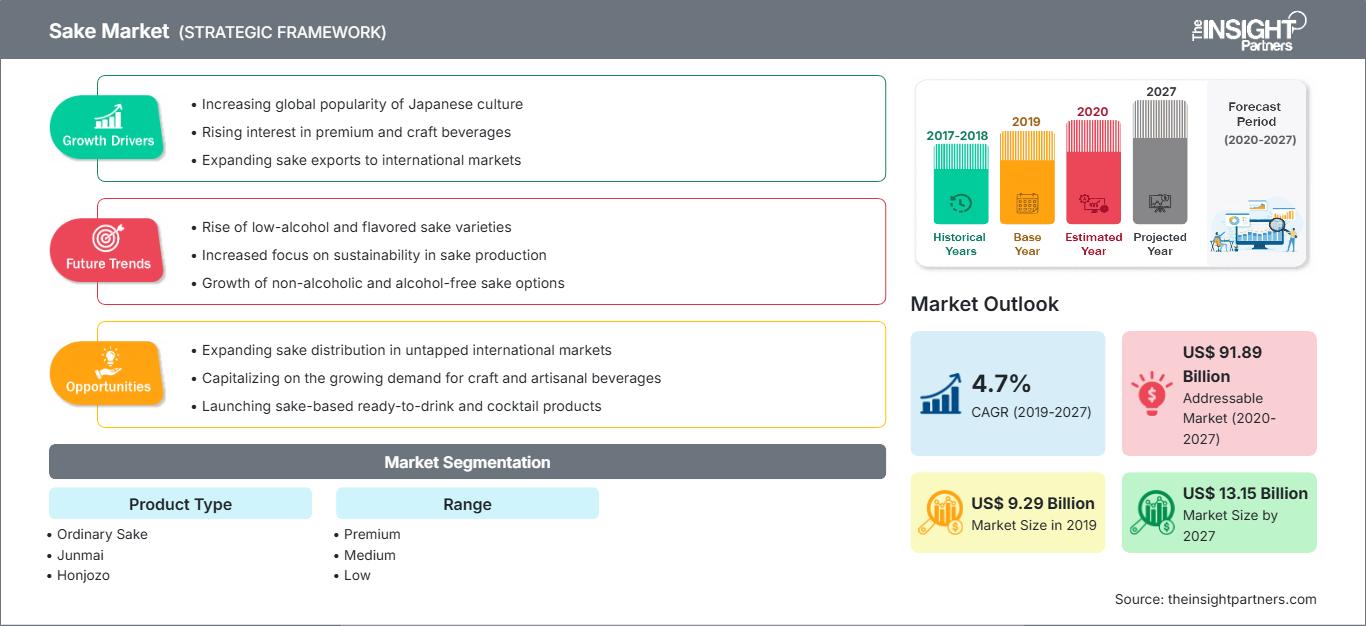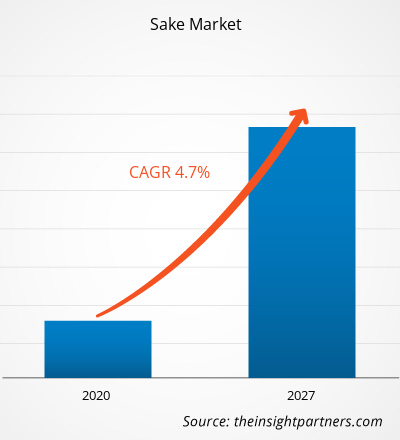Il mercato del sakè è stato valutato a 9.290,16 milioni di dollari nel 2019 e si prevede che raggiungerà i 13.146,68 milioni di dollari entro il 2027; si prevede una crescita a un CAGR del 4,7% dal 2020 al 2027.
Il sakè è una bevanda alcolica giapponese prodotta con riso fermentato e chiamata anche vino di riso. Il sakè viene generalmente prodotto utilizzando riso sake mai raffinato, una muffa nota come Aspergillus oryzae, acqua e lievito. I sakè di qualità vengono invecchiati per più di un anno e la maggior parte delle varianti ha un contenuto alcolico compreso tra il 15% e il 20%.
Si prevede che il mercato del sakè in Nord America crescerà al CAGR più elevato durante il periodo di previsione. La crescita del mercato del sakè in questa regione è principalmente attribuibile al crescente consumo di bevande alcoliche in Nord America. La crescente domanda di bevande alcoliche, tra cui il sakè, è stata soddisfatta dall'aumento del numero di birrifici e distillerie nella regione. La crescente domanda di sakè in Nord America ha spinto i produttori a stabilirsi nella regione, alimentando ulteriormente la crescita del mercato del sakè in Nord America. La presenza di aziende affermate come Takara Sake USA Inc., Gekkeikan Sake e Ozeki Sake sta offrendo opportunità di crescita per il mercato del sakè in Nord America.
Personalizza questo rapporto in base alle tue esigenze
Potrai personalizzare gratuitamente qualsiasi rapporto, comprese parti di questo rapporto, o analisi a livello di paese, pacchetto dati Excel, oltre a usufruire di grandi offerte e sconti per start-up e università
Mercato del sakè: Approfondimenti strategici

- Ottieni le principali tendenze chiave del mercato di questo rapporto.Questo campione GRATUITO includerà l'analisi dei dati, che vanno dalle tendenze di mercato alle stime e alle previsioni.
Impatto della pandemia di COVID-19 sul mercato del sakè
Potrai personalizzare gratuitamente qualsiasi rapporto, comprese parti di questo rapporto, o analisi a livello di paese, pacchetto dati Excel, oltre a usufruire di grandi offerte e sconti per start-up e università
Mercato del sakè: Approfondimenti strategici

- Ottieni le principali tendenze chiave del mercato di questo rapporto.Questo campione GRATUITO includerà l'analisi dei dati, che vanno dalle tendenze di mercato alle stime e alle previsioni.
L'epidemia di COVID-19 ha avuto un impatto negativo sulle economie e sui settori industriali di diversi paesi a causa di lockdown, divieti di viaggio e chiusure delle attività. Tra i settori più significativi che hanno subito gravi interruzioni, come restrizioni alla catena di approvvigionamento e chiusura degli impianti di produzione, rientrano alimenti e bevande. La chiusura di diversi impianti e fabbriche in diversi paesi interrompe le catene di approvvigionamento globali e ha un impatto negativo sulle attività produttive, sui tempi di consegna e sulle vendite di beni di largo consumo. La pandemia di COVID ha inizialmente interrotto la domanda di alcolici a causa della chiusura di ristoranti, fornitori di servizi di ristorazione, negozi di liquori, hotel e bar, con un impatto negativo sul mercato del sakè. La chiusura di negozi e pub locali ha generato opportunità per i fornitori di servizi online, stabilizzando la domanda di bevande alcoliche durante il periodo della pandemia, con un impatto positivo sul mercato del sakè. Pertanto, inizialmente il COVID-19 ha avuto un impatto negativo sul mercato del sakè, ma con l'aumento della domanda di alcolici, la domanda di sakè è aumentata lentamente e costantemente.
Analisi di mercato: aumento delle esportazioni di sakè
Il calo della domanda di sakè in Giappone e nei paesi dell'Asia-Pacifico ha portato a un aumento delle esportazioni di sakè. L'elevato consumo di alcolici e la forte propensione delle persone verso le bevande tradizionali negli Stati Uniti hanno portato a un aumento delle esportazioni di sakè verso gli Stati Uniti. La crescente crescita del numero di ristoranti giapponesi in regioni come Europa e Nord America ha portato a un aumento della domanda di sakè. L'elevato apprezzamento e la crescente tendenza ad abbinare varietà culinarie al sakè stanno portando a un aumento delle esportazioni di sakè in diversi paesi.
Analisi del tipo di prodotto
In base al tipo di prodotto, il mercato del sakè si divide in sakè ordinario, Junmai, Honjozo, Junmai Ginjo, Ginjo e Junmai Daiginjo. Il segmento del sake ordinario ha rappresentato la quota maggiore di mercato nel 2019; mentre si prevede che il segmento del sake Junmai registrerà il CAGR più elevato tra il 2020 e il 2027. Il sake ordinario è anche chiamato Futsū-shu, equivalente a un vino da tavola, e rappresenta la maggior parte del sake prodotto. Secondo Takara Sake, il sake ordinario comprende circa due terzi della produzione mondiale di sake, con un sapore e un corpo delicati, un palato dolce e un'acidità minima o nulla. Il riso utilizzato per produrre il sake ordinario è raffinato al 70% e può contenere o meno alcol di fermentazione aggiunto.
Approfondimenti sulla gamma
In base alla gamma, il mercato del sake è segmentato in premium, medio e basso. Il segmento basso ha rappresentato la quota maggiore di mercato nel 2019 e si prevede che il segmento premium registrerà il CAGR più rapido tra il 2020 e il 2027. Il segmento di prezzo basso del sakè viene prodotto per ottenere il massimo rendimento e valore, utilizzando riso di qualità inferiore, per lo più raffinato al di sotto del 30%. La maggior parte del sakè prodotto rientra nel segmento di prezzo basso.
Alcuni attori che operano nel mercato del sakè sono Aramasa Co, Ltd.; Asahishuzo CO., Ltd.; Blue Current Brewery; Gekkeikan Sake Co., Ltd; Hakutsuru Sake Brewing Co., Ltd; Kanpai London; Craft Sake; Ozeki Corporation; Sun Masamune Pty Limited; Takara Sake USA Inc.; Tatsuuma-Honke Brewing Co. Ltd., tra molti altri. Le aziende chiave implementano fusioni e acquisizioni, nonché strategie di ricerca e sviluppo per espandere la base clienti e acquisire quote significative nel mercato globale, il che consente loro anche di mantenere il proprio marchio a livello globale.
Mercato del sakè
Le tendenze regionali e i fattori che influenzano il mercato del sakè durante il periodo di previsione sono stati ampiamente spiegati dagli analisti di The Insight Partners. Questa sezione analizza anche i segmenti e la geografia del mercato del sakè in Nord America, Europa, Asia-Pacifico, Medio Oriente e Africa, America Meridionale e Centrale.
Ambito del rapporto sul mercato del sakè
| Attributo del rapporto | Dettagli |
|---|---|
| Dimensioni del mercato in 2019 | US$ 9.29 Billion |
| Dimensioni del mercato per 2027 | US$ 13.15 Billion |
| CAGR globale (2019 - 2027) | 4.7% |
| Dati storici | 2017-2018 |
| Periodo di previsione | 2020-2027 |
| Segmenti coperti |
By Tipo di prodotto
|
| Regioni e paesi coperti | Nord America
|
| Leader di mercato e profili aziendali chiave |
|
Densità degli operatori del mercato del sakè: comprendere il suo impatto sulle dinamiche aziendali
Il mercato del sakè è in rapida crescita, trainato dalla crescente domanda da parte dei consumatori finali, dovuta a fattori quali l'evoluzione delle preferenze dei consumatori, i progressi tecnologici e una maggiore consapevolezza dei benefici del prodotto. Con l'aumento della domanda, le aziende stanno ampliando la propria offerta, innovando per soddisfare le esigenze dei consumatori e sfruttando le tendenze emergenti, alimentando ulteriormente la crescita del mercato.

- Ottieni il Mercato del sakè Panoramica dei principali attori chiave
- Tendenze progressive del settore nel mercato globale del sakè per aiutare gli operatori a sviluppare strategie efficaci a lungo termine
- Strategie di crescita aziendale adottate dai mercati sviluppati e in via di sviluppo
- Analisi quantitativa del mercato globale del sakè dal 2017 al 2027
- Stima della domanda globale di sakè in vari settori
- Analisi PEST per illustrare l'efficacia di acquirenti e fornitori che operano nel settore
- Sviluppi recenti per comprendere lo scenario competitivo del mercato e la domanda globale di sakè
- Tendenze e prospettive di mercato, nonché fattori che guidano e frenano la crescita del mercato globale del sakè
- Processo decisionale attraverso la comprensione delle strategie che sostengono l'interesse commerciale in relazione alla crescita del mercato.
- Dimensioni del mercato globale del sakè in vari nodi del mercato
- Panoramica dettagliata e segmentazione del mercato globale del sakè, nonché delle sue dinamiche di settore
- Dimensioni del mercato globale del sakè in varie regioni con una crescita promettente opportunità
Mercato del sakè - per tipo di prodotto
- Sakè ordinario
- Junmai
- Honjozo
- Junmai Ginjo
- Ginjo
- Junmai Daiginjo
Mercato del sakè - per gamma
- Premium
- Medio
- Basso
Profili aziendali
- Aramasa Co, Ltd.;
- Asahishuzo CO., Ltd.
- Blue Current Brewery
- Gekkeikan Sake Co., Ltd
- Hakutsuru Sake Brewing Co., Ltd
- Kanpai London Craft Sake
- Ozeki Corporation
- Sun Masamune Pty Limited
- Takara Sake USA Inc.
- Tatsuuma-Honke Brewing Co. Ltd.
- Analisi storica (2 anni), anno base, previsione (7 anni) con CAGR
- Analisi PEST e SWOT
- Valore/volume delle dimensioni del mercato - Globale, Regionale, Nazionale
- Industria e panorama competitivo
- Set di dati Excel
Report recenti
Testimonianze
Motivo dell'acquisto
- Processo decisionale informato
- Comprensione delle dinamiche di mercato
- Analisi competitiva
- Analisi dei clienti
- Previsioni di mercato
- Mitigazione del rischio
- Pianificazione strategica
- Giustificazione degli investimenti
- Identificazione dei mercati emergenti
- Miglioramento delle strategie di marketing
- Aumento dell'efficienza operativa
- Allineamento alle tendenze normative




















 Ottieni un campione gratuito per - Mercato del sakè
Ottieni un campione gratuito per - Mercato del sakè